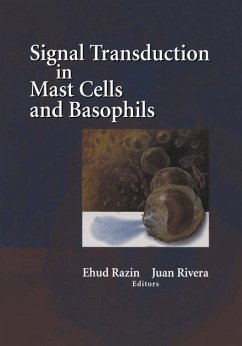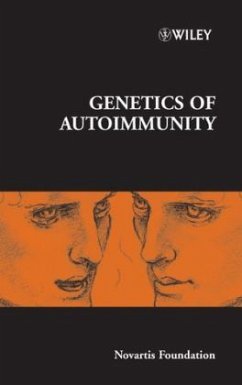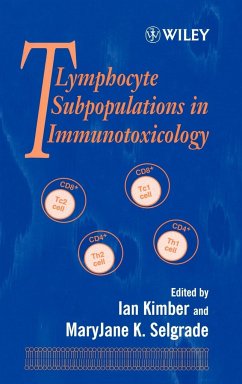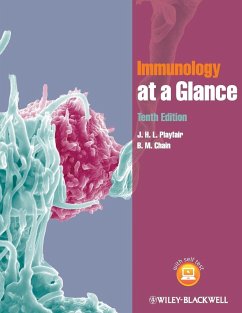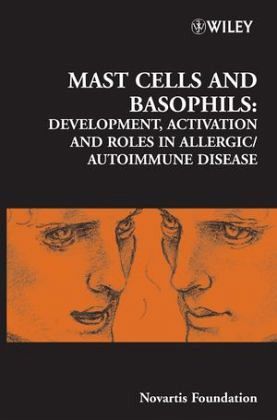
Mast Cells and Basophils
Development, Activation and Roles in Allergic / Autoimmune Disease
Herausgeber: Chadwick, Derek J; Goode, Jamie A

PAYBACK Punkte
95 °P sammeln!
Focusing on the latest basic (primarily molecular) research on the mast cell and basophil and its significance in relation to allergic and autoimmune diseases- an important area in the effort to develop therapeutics for allergic disorders- Mast Cells and Basophils- No 271: Development, Activation and Roles in Alelrgic/Autoimmune Disease presents recent advances relating to the factors and mechanisms that regulate the growth, differentiation, and function of mast cells and basophils. Coverage includes: a discussion of new technologies used to study these cells and integration of the basic scientific findings in the context of therapeutic possibilities for the treatment of diseases such as allergic inflammation and autoimmune disease which are mediated, in part, by these granulocytes.
This exciting new book addresses the latest research on mast cells and basophils and its significance in relation to allergic and autoimmune diseases. This is an area of burgeoning interest, driven by increasing recognition of the fundamental importance of these cell types in several disease processes.
The book covers recent advances relating to the factors and mechanisms that regulate the growth, differentiation and function of mast cells and basophils. It describes new technologies used to study these cells. It also discusses how the basic scientific findings can be integrated into possible therapeutic applications.
The topics covered include (1) the development of mast cells and basophils; (2) early and late events in IgE/antigen activation of mast cells and basophils; (3) mechanisms of exocytosis; (4) non-IgE-mediated activation of mast cells and basophils, as well as of surface receptors that dampen activation responses; (5) protease, proteoglycan, lipid and cytokine mediators released from activated mast cells and basophils; and (6) bilateral interactions of mast cells with other cell types.
The book focuses on the role of mast cells and basophils in disease. Some of the discussions examine the part played by mast cells in allergic inflammation and the effect of stabilization of these cells in novel therapies. There is also discussion of mastocytosis and the underlying mutations. Recent evidence implicates mast cells in multiple sclerosis, diabetes and HIV-1 infection, and other studies identify mast cells in processes that control the onset and severity of experimental allergic encephalomyelitis and insulin-dependent diabetes in mice. The strategic location of mast cells in the central nervous system (in multiple sclerosis) and in the pancreas (in diabetes), as well as their ability to express a variety of cytokines and other inflammatory mediators, raises the possibility that mast cells either initiate the inflammatory responses directly or modulate the character of the T cell response.
Up-to-date and containing contributions from world leaders in the field, this book will be required reading for basic scientists and clinicians with an interest in mast cells and the related diseases.
The book covers recent advances relating to the factors and mechanisms that regulate the growth, differentiation and function of mast cells and basophils. It describes new technologies used to study these cells. It also discusses how the basic scientific findings can be integrated into possible therapeutic applications.
The topics covered include (1) the development of mast cells and basophils; (2) early and late events in IgE/antigen activation of mast cells and basophils; (3) mechanisms of exocytosis; (4) non-IgE-mediated activation of mast cells and basophils, as well as of surface receptors that dampen activation responses; (5) protease, proteoglycan, lipid and cytokine mediators released from activated mast cells and basophils; and (6) bilateral interactions of mast cells with other cell types.
The book focuses on the role of mast cells and basophils in disease. Some of the discussions examine the part played by mast cells in allergic inflammation and the effect of stabilization of these cells in novel therapies. There is also discussion of mastocytosis and the underlying mutations. Recent evidence implicates mast cells in multiple sclerosis, diabetes and HIV-1 infection, and other studies identify mast cells in processes that control the onset and severity of experimental allergic encephalomyelitis and insulin-dependent diabetes in mice. The strategic location of mast cells in the central nervous system (in multiple sclerosis) and in the pancreas (in diabetes), as well as their ability to express a variety of cytokines and other inflammatory mediators, raises the possibility that mast cells either initiate the inflammatory responses directly or modulate the character of the T cell response.
Up-to-date and containing contributions from world leaders in the field, this book will be required reading for basic scientists and clinicians with an interest in mast cells and the related diseases.



